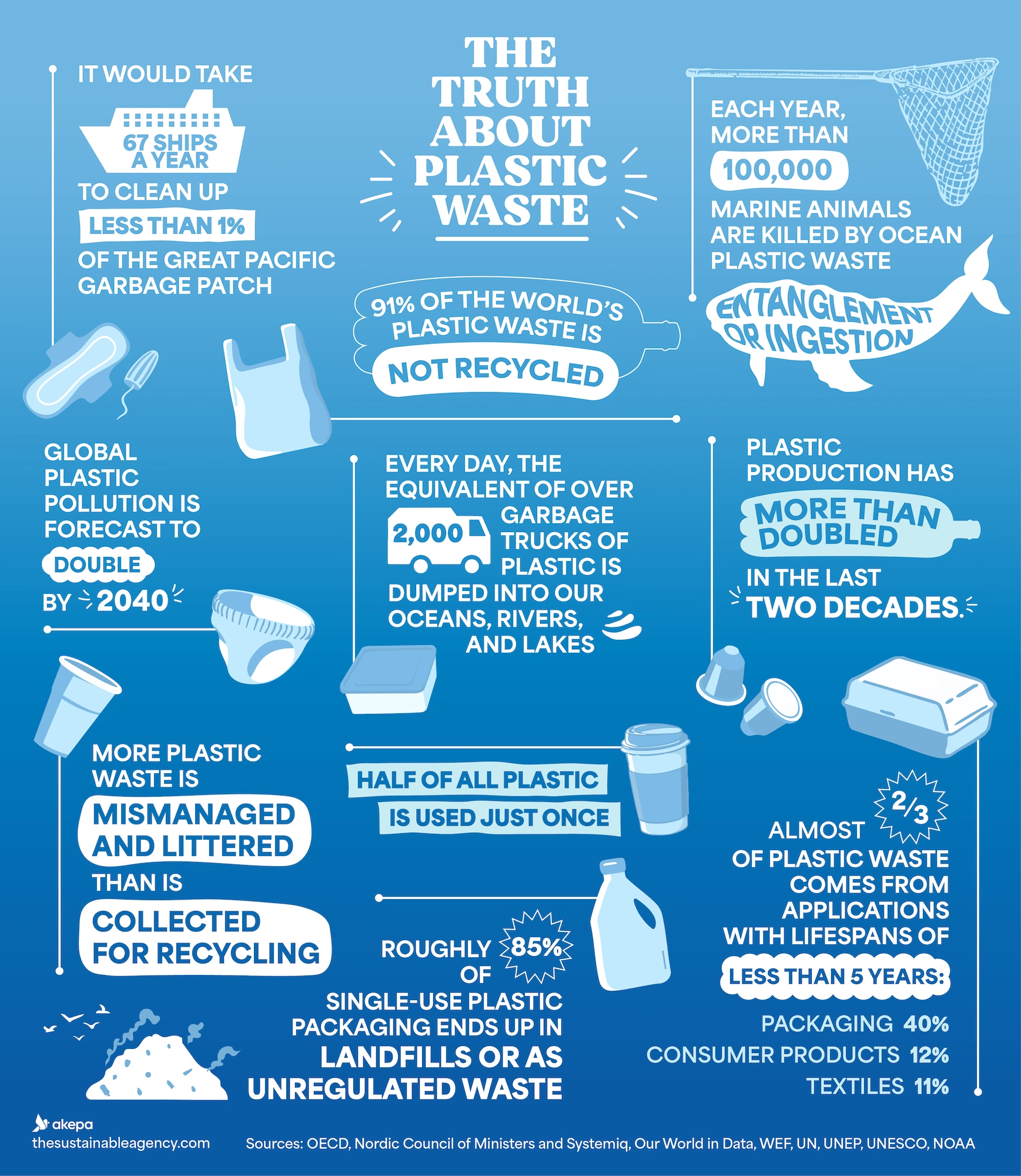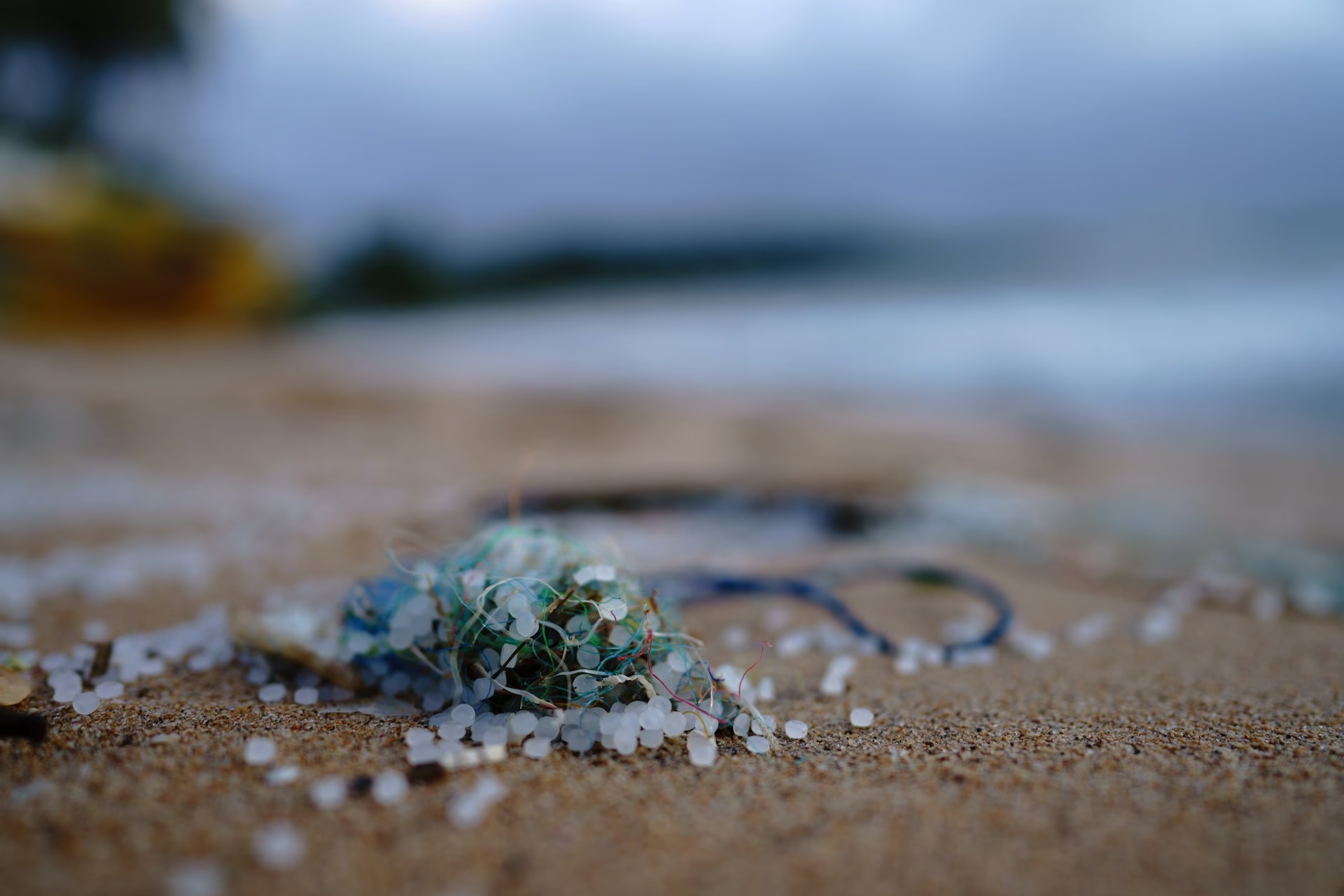There could be more plastic than fish in the sea by 2050.
That’s a worrying prediction from the Ellen Macarthur Foundation. And while its accuracy, at such a long range, is debatable, it’s nevertheless indicative of the ominous situation we’ve created with our out-of-control plastic use. Unless we take action, the future is looking trashy.
As sustainable marketers here at Akepa, we look at sustainability through various lenses – with one of the main ones being the environmental. We’re always keen to investigate what’s going on out there – and not just by listening to opinions but through stats, facts, and research that tell us exactly what the state of things is.
So we’ve compiled 20 statistics on the environmental impact of plastic pollution and how it’s contributing to the climate crisis, threatening biodiversity, upsetting food systems, and more.
Here goes – and we’ll be keeping this list updated as new evidence comes to light. We’ve also crammed some of the key stats into an infographic, which you can see below. Feel free to share it to spread awareness!

- Let’s start with the scary stat we began the article with. The Ellen Macarthur Foundation predicted that if we don’t act now then there could be more plastic than fish in our oceans by 2050. This projection is based on our current use and the rate of growth, meaning the amount of plastic in the ocean would exceed 600m tonnes. (Ellen Macarthur Foundation, 2022).
- Plastic recycling might seem easy enough – on the surface – but 91% of the world’s plastic waste is still not recycled. (OECD, 2022)
- In a business-as-usual scenario, mismanaged plastic waste (plastic that isn’t recycled, landfilled, or incinerated) would almost double from 2019 to 2040. / Global plastic pollution is forecast to double by 2040. (Nordic Council of Ministers and Systemiq, 2023)
- More plastic waste is mismanaged and littered (22%) than is collected for recycling (15%). (OECD, 2022)
- Plastic production has more than doubled in the last two decades. (Our World in Data, 2023)
- Almost ⅔ of plastic waste comes from applications with lifespans of less than 5 years, including packaging (40%), consumer products (12%), and textiles (11%). (OECD, 2022)
- Half of all plastic produced is used just once. (WEF, 2021)
- Every day, the equivalent of over 2,000 garbage trucks full of plastic is dumped into our oceans, rivers, and lakes. (UN, 2023)
- Roughly 85% of single-use plastic packaging ends up in landfills or as unregulated waste. (UNEP, 2023)
- More than 100,000 marine mammals are killed by ocean plastic waste entanglement or ingestion each year. (UNESCO, 2022)
- It’s estimated that it would take 67 ships a year to clean up less than 1% of the Great Pacific Garbage Patch. (NOAA, n.d.)
- Global plastic production now exceeds 400m tonnes and is forecast to reach approximately 1 billion tonnes by 2050 – under a business as usual scenario (Our World in Data, 2025).
- The Great Pacific Garbage patch is a massive, expanding, collection of plastic in the North Pacific Ocean. It’s the largest accumulation of ocean plastic in the world. Back in 2018 it was approximately three times the size of France, and has since grown. (Nature, 2018).
- Zoning in on Coca Cola, which is by many measures the largest plastic polluter on the planet, the amount of plastic released into the world’s waterways just from this firm will reach 602 million kg by 2030, unless the company changes its practices. (Oceana, 2025)
- Almost 70% of plastic pollution is created by just 20 countries, which is about 10% of the planet’s 195 countries. (Nature, 2024).
- India, the world’s most populous country – after overtaking China in 2023 – is now also responsible for the most plastic pollution – accounting for around 20% of the world’s waste. The next countries in the top 5, are – in order – Nigeria, Indonesia, China, and Pakistan. (University of Leeds, 2024)
- Plastic production and disposal accounts for around 5% of global GHG emissions. (Lawrence Berkeley National Laboratory, 2024).
- Microplastics are an emerging menace – a threat to ecosystems that have even been found in human and animal bodies. But what is a ‘microplastic’? The definition is a tiny piece of plastic that’s less than 5mm long. We’ll be creating a separate article and graphic about microplastics soon, as they merit a damning post of their own.
These are all pretty convincing stats, but still, you – like us – might wonder what on earth we can do when plastic is so ubiquitous and also so practical? What can we replace it with? If you’ve every tried to go plastic-free for a bit then you’ll know how much of a fandango it becomes, despite noble intentions.
We don’t have all the answers but there are certainly some amazing innovations out there. Take this interview we did with Great Wrap, who create a compostable plastic wrap that looks and functions just like the real thing. The key thing is making these alternatives affordable and scaleable, to take on the might of plastic.
That, and taking small steps to avoid buying or using products with unnecessary plastic. Take a cloth bag (or used plastic bag) to the supermarket. Don’t buy vegetables wrapped in clingfilm. Avoid bottled water if you can. Cook more. Recycle the plastic that you can. Little steps like that can help.
However plastic is replaced, being aware of the awful stats on what plastic is doing to our planet is a good first step towards change. So we hope we’ve helped a little on that side.
After all, plastic is not fantastic. It’s deeply problematic.



Leave a Reply